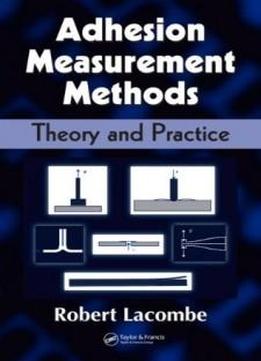
Adhesion Measurement Methods: Theory And Practice (mechanical Engineering (marcel Dekker))
by Robert Lacombe /
2005 / English / PDF
5.7 MB Download
Adhesion Measurement Methods: Theory and Practice provides
practical information on the most important measurement techniques,
their unique advantages and disadvantages, and the selection of the
proper method for a given application. It includes useful
information and formulae on adhesion related matters such as
driving force formulae for various modes of delamination, methods
for estimating stress buildup, and material property data in
support of "back of the envelope" calculations.
Adhesion Measurement Methods: Theory and Practice provides
practical information on the most important measurement techniques,
their unique advantages and disadvantages, and the selection of the
proper method for a given application. It includes useful
information and formulae on adhesion related matters such as
driving force formulae for various modes of delamination, methods
for estimating stress buildup, and material property data in
support of "back of the envelope" calculations.
The author presents optimal methods and tools used for measuring
the adhesion of coatings and thin films as well as setting
appropriate adhesion strength requirements. He provides a detailed
overview of uses, implementation, and drawbacks for qualitative,
semi-quantitative, and fully quantitative adhesion measurement
techniques and self-loading systems. The book discusses
thermal-mechanical behavior assessment, the application of the
continuum theory of solids, and fracture mechanics, highlighting
useful measures of adhesion strength such as stress intensity
factor and strain energy release rate. It provides specific
examples of how adhesion testing is carried out in practice,
including the peel test, the scratch test, and the pull test, and
describes the measurement of residual stress in a coating or other
laminate structure. The book concludes with examples taken from the
author's experience in the microelectronics industry and contains
several appendices for looking up simple formulae and material
property data for performing everyday calculations.
The author presents optimal methods and tools used for measuring
the adhesion of coatings and thin films as well as setting
appropriate adhesion strength requirements. He provides a detailed
overview of uses, implementation, and drawbacks for qualitative,
semi-quantitative, and fully quantitative adhesion measurement
techniques and self-loading systems. The book discusses
thermal-mechanical behavior assessment, the application of the
continuum theory of solids, and fracture mechanics, highlighting
useful measures of adhesion strength such as stress intensity
factor and strain energy release rate. It provides specific
examples of how adhesion testing is carried out in practice,
including the peel test, the scratch test, and the pull test, and
describes the measurement of residual stress in a coating or other
laminate structure. The book concludes with examples taken from the
author's experience in the microelectronics industry and contains
several appendices for looking up simple formulae and material
property data for performing everyday calculations.
Adhesion Measurement Methods is an ideal addition for courses on
materials science, mechanics of materials, or engineering design of
laminate structures at the advanced undergraduate or graduate
level.
Adhesion Measurement Methods is an ideal addition for courses on
materials science, mechanics of materials, or engineering design of
laminate structures at the advanced undergraduate or graduate
level.











